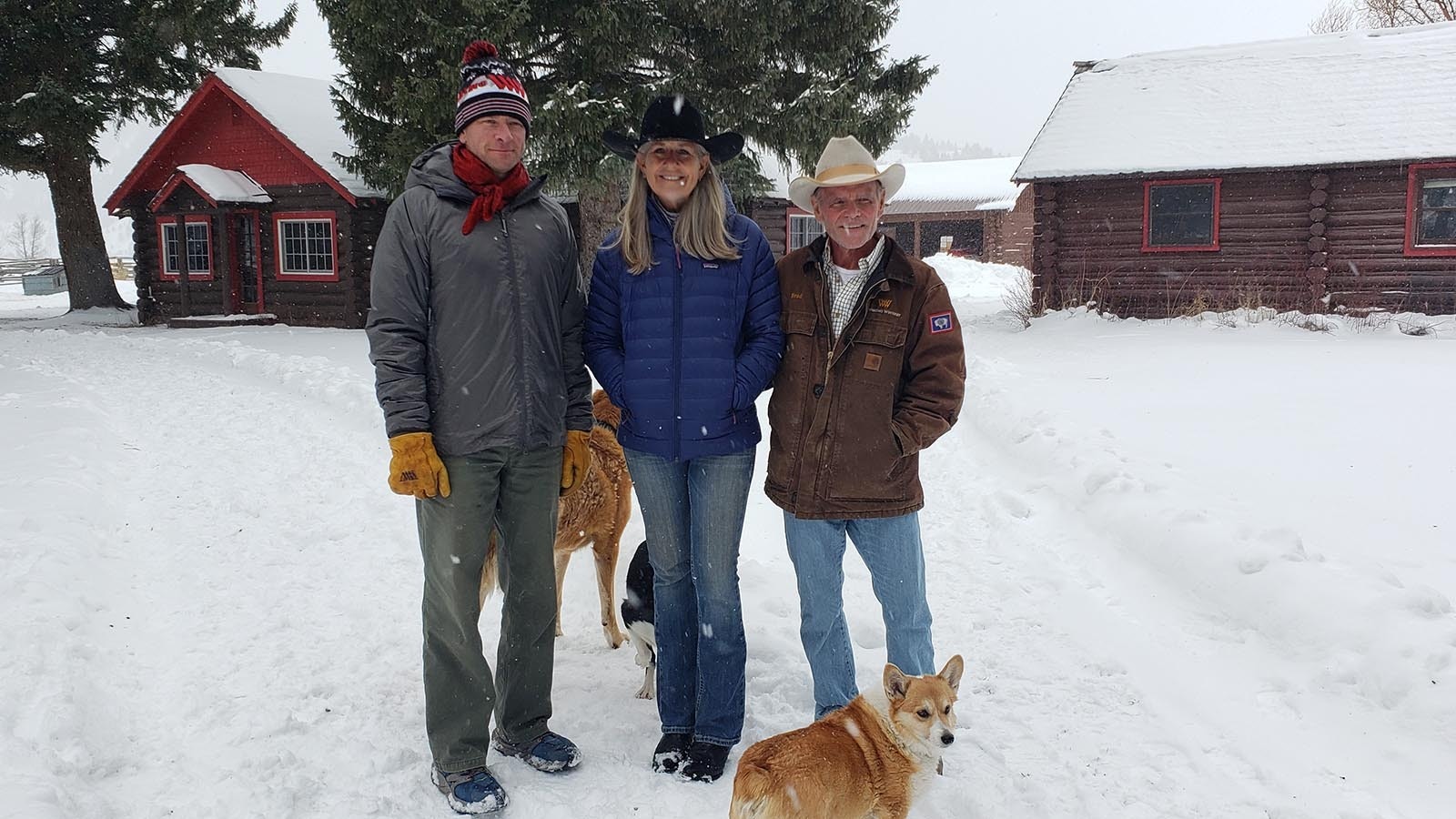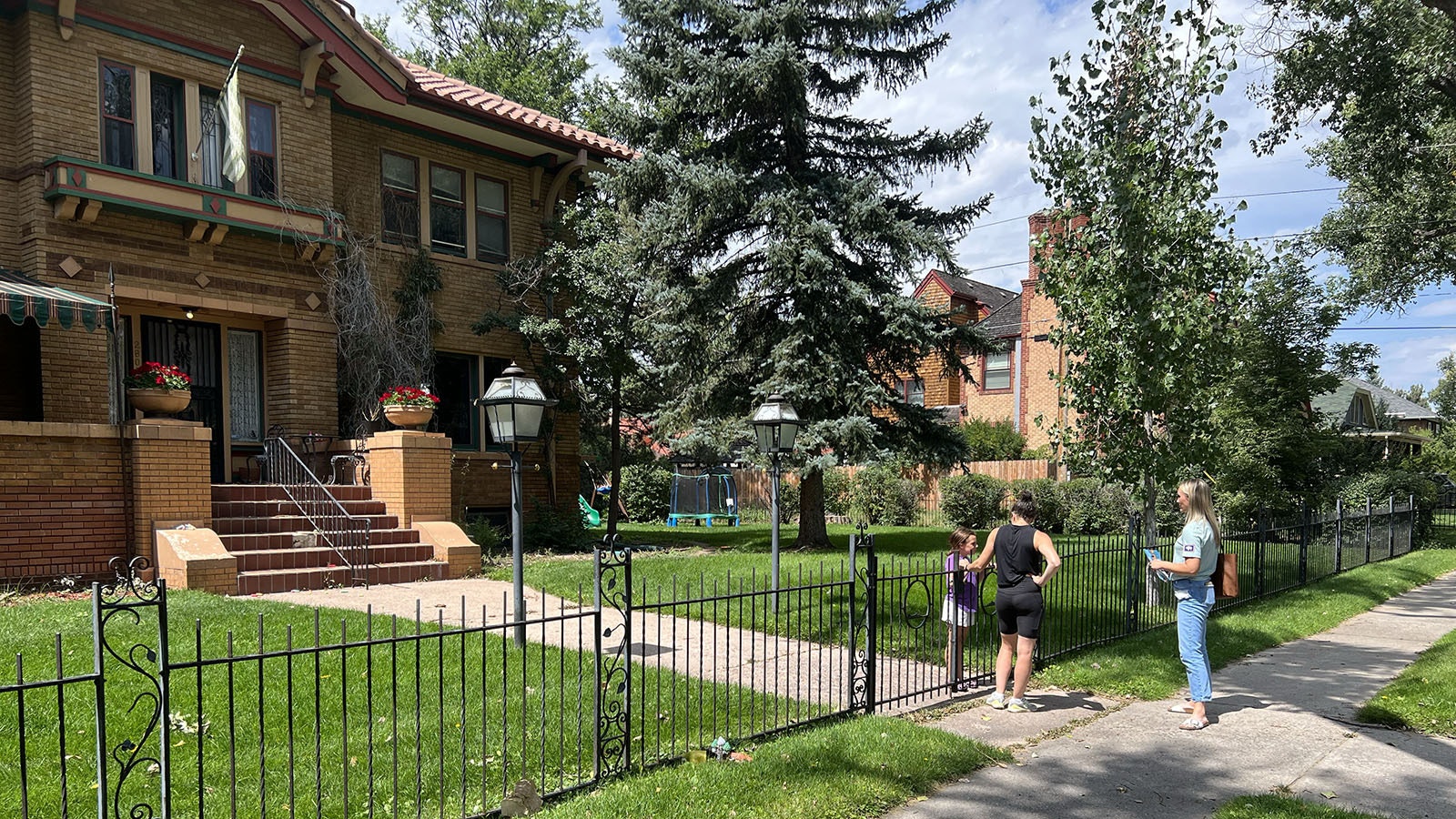By Renée Jean, Business and Tourism Reporter
renee@cowboystatedaily.com
Kate and Brad Mead live on a perfectly splendid Jackson, Wyoming, ranch nestled among the foothills in Spring Gulch crowned by the majestic Grand Tetons in the distance.
The ranch comes complete with a “unicorn” horse — Rowdy was his name, until he got a unicorn rainbow pattern to delight a grandchild. Now the horse is known as Rainbow.
Rainbow is still rowdy, Kate Mead said with a chuckle as she and her husband showed their snow-laden ranch to a group of people there to learn more about the success of Wyoming Whiskey, which is now 10 years old.

Going International
Not only is Wyoming Whiskey releasing an anniversary product to celebrate a decade of producing spirits, it’s also talking about a long-term future that includes international sales not just in Canada, but the UK and beyond.
Of course, even perfectly splendid ranches have their problems from time to time, regardless of unicorn horses, and the Mead Ranch is no different.
In fact, Wyoming Whiskey came about after a terrible problem. Brucellosis was confirmed in a neighbor’s cattle, and the entire herd had to be destroyed.
The federal government gives ranchers the option to quarantine herds, Brad Mead said.
“But nobody can afford to keep cows for 12 months just feeding and feeding them,” he said. “So as a practical matter, you end up destroying the entire herd.”
Out Of Destruction, Something New
Beautiful things are often wrought unwillingly in the midst of tragedy. But that wasn’t something the couple was thinking about at the time.
Instead, they were on focused on preventing what happened to their neighbor from happening to them. To solve that issue, they bought 1,000 acres in Kirby so they could send their cattle away whenever the risk of brucellosis became high, as it does this time of the year.
“I know this is more about the whiskey than the ranch,” Brad Mead said. “But the ranch led to the whiskey.”




Diversify To Survive
Like most cattle ranchers today, the Meads really needed to diversify their operation to remain profitable.
Kate, for example, had found a niche selling fresh beef at farmers markets. The couple also rent the ranch at times, which makes a good venue for events.
Having 1,000 or so acres sitting mostly empty for so much of the year gnawed at them. There had to be ways they could use that land to strengthen the ranch.
Kate was intrigued by the idea of a vineyard, but Brad was not convinced. He feared the climate would not favor grapes without a lot of work.
As a bourbon drinker, he realized during this brainstorming process that the Kirby property actually has almost everything needed for making whiskey.
“We had great water,” he said. “We could grow grains there. It seemed like we had all the right ingredients — except for any idea how to do it.”
Mead called David DeFazio and told him the couple wanted to make whiskey.
DeFazio’s first question was simple.
“How do you do that?”
“Well, that’s for you to figure out,” Brad recalls telling him.
Learning From Kentucky Masters
The two made several trips to Kentucky to learn about the industry together, figuring out what they would need to start a whiskey still.
Among those visits was one with a world-famous company that makes copper stills.
“We’ll make you a still, and we’ll never duplicate it,” they told Brad.
It was like a “Godfather” moment – an offer Brad Mead just could not refuse. Before he knew it, he’d signed a contract to buy a giant copper still.
Now he had to tell Kate, who was not yet convinced whiskey was the way to go.
“I thought it was a boondoggle,” Kate Mead told Cowboy State Daily. “Brad and David would go off to like the bourbon festival and I was like, ‘Oh, that’s nice. Oh, great.’ And then they came back with a still.”
Kate’s first question when Brad told her what he’d done was all about practicality.
“Can it fit in the garage?” she asked.
Brad shook his head. “It’s 38 feet tall.”
A garage wasn’t going to work.

Now What?
Several months and big trucks later, the components of the still finally arrived. These were heavy, huge pieces of copper and glass, now laying on the grounds of the property in haphazard fashion.
Its new owners had no idea how to put it together or what to do next.
“Luckily, through friends and connections, we ended up connecting with a guy named Lincoln Henderson, who was a renowned distiller, famous in the industry,” Brad Mead said.
Henderson saved the still, helping the Meads design and set it up in a way that would make sense for their Wyoming operation.
Brad soon realized, however, that the size of the distillery didn’t just mean future capacity some far away day down the line.
“I’m happy with it now, but then it was like feeding the beast,” he recalled. “It took three guys 24 hours a day, I mean it was huge.”
Not Wheat Farmers After All
Kate and Brad Mead also planted 40 acres of wheat after the still arrived, thinking they would grow their own grains for their whiskey.
But they soon learned that they are cattle ranchers, not wheat farmers.
Fortunately, they also met a world-class wheat farmer named Brent Raglans. Not only was he enthusiastic about the idea of a Wyoming whiskey, he also knew just what varieties of grains the couple needed to grow for that whiskey.
Meanwhile, the couple convinced retired master distiller Steve Nally, who had worked at Maker’s Mark for three decades, to come out of retirement and help them get started.
For five years, Nally helped the Meads elevate their whiskey and make it into a remarkable product, one that’s attracting not just national, but international interest.
Included in this incredible string of good luck were changes to the market itself. The price of wine took a nosedive, Kate Mead said, and suddenly people became very interested in tasting bourbon.
“Suddenly we had an advantage,” Brad Mead recalled. “We had bourbon that was already 3 years old.”
A New Star Is Born
After Nally left, world-class veteran Nancy Fraley joined Wyoming Whiskey to shepherd and develop its blends. She tastes 100 barrels of whiskey a day when she visits Wyoming from California and said she’s tasted 9,000 barrels of Wyoming Whiskey to date.
She and Nally teamed up to blend the 10-year anniversary whiskey, which has just been released.
It starts out sweet on the tongue, but quickly announces itself as something else with a spicy kick. It’s smooth going down despite the ticklish fire that accompanies even a tiny sip.
Retailers have already bought every available bottle of the anniversary edition to sell in stores. That doesn’t mean the whiskey is no longer available. Consumers can still get a bottle of the limited-edition whiskey in retail stores that carry the brand. Suggested retail is $200 a bottle.
That may sound expensive, but given the 10-year timeframe involved in developing the product, and the amount of work involved between Fraley and Nally on their collaboration, the price point is less than some marketers had recommended to them, Brad Mead said.
“We wanted to keep it affordable to Wyoming bourbon drinkers,” he said.
The Next Decade
“In 2018, we partnered with a company from Scotland that has a long track record, a very successful track record, and they’re interested in having an American whiskey,” Brad Mead told Cowboy State Daily.
That company is doing all of its distributing and marketing now. The Meads believe they will soon also be selling bottles of Wyoming Whiskey in the UK within the next couple of years.
“I think in the next five to 10 years, we’re going to build the volume we’re doing now to far more than that,” Mead said.
They will also add more employees to the 15 they already have as part of Wyoming Whiskey.
The couple’s original mission statement was to create a product that showcases Wyoming’s natural resources in a way that makes the state proud.
Both now believe they have accomplished that, and Kate has no regrets about the unrealized vinyard.





